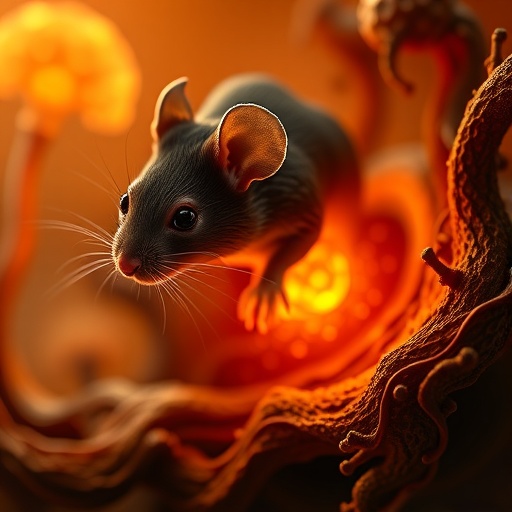In a groundbreaking revelation that reshapes our understanding of microbial defense strategies within the mammalian gut, researchers have uncovered a remarkable link between anoxia—a condition characterized by the absence of oxygen—and the activation of CRISPR–Cas immunity in the mouse intestine. This study, recently published in Nature Microbiology, offers compelling insights into how environmental factors translate into molecular immune responses, potentially opening avenues for innovative therapeutic interventions targeting the human microbiome.
The mammalian intestine is an intricate ecosystem where trillions of microbes coexist, communicate, and compete. Among these microbes, bacteria wield the CRISPR–Cas system, a highly adaptive immune mechanism that allows them to fend off viral invaders like bacteriophages. Traditionally, CRISPR–Cas systems have been studied in relatively stable laboratory conditions, but little was known about how physiological changes in the host environment might influence bacterial immune activity. The current research bridges this gap by examining the impact of an oxygen-deficient intestine on CRISPR functionality in vivo.
Understanding anoxia’s role in modulating gut microbial immunity begins with examining the natural oxygen gradients within the intestine. The gut is far from a uniform environment; oxygen levels dramatically decline from the vascularized mucosal surface to the anaerobic lumen. This oxygen gradient imposes survival challenges on resident bacteria. Campbell, I.W. and colleagues hypothesized that such hypoxic or anoxic conditions could act as environmental cues, triggering microbial defensive mechanisms to ensure survival against phage predation during vulnerable metabolic states.
To probe this hypothesis, the researchers employed sophisticated mouse models whose intestinal oxygenation could be manipulated. By measuring CRISPR–Cas gene expression profiles and phases of phage infection, they were able to correlate oxygen levels with the immune activation status of bacterial communities. The findings reveal that during anoxic episodes, CRISPR–Cas systems ramp up activity, enhancing spacer acquisition and interference capabilities against invading phages. This adaptive response likely confers a survival advantage when bacteria endure the stress of oxygen deprivation.
The underlying molecular pathways linking anoxia to CRISPR activation remain complex. The study points to metabolic sensors that bacterial cells employ to detect oxygen scarcity and modulate gene regulatory networks. Hypoxia-induced transcription factors appear to intersect with CRISPR-associated loci promoters, enhancing the expression of Cas proteins essential for DNA targeting and cleavage. This cross-regulation intertwines cellular metabolism with immune defense, illustrating a sophisticated integration between environmental sensing and genome protection.
Beyond mechanistic insights, this research spotlights the dynamic interplay between host physiology and microbial immunity. The gut environment fluctuates continuously, influenced by diet, circadian rhythms, and disease states. The discovery that gut anoxia modulates bacterial CRISPR activity introduces a new paradigm where host-induced environmental changes can shape microbial population dynamics and evolutionary trajectories. Such knowledge could inform how we manipulate the gut microbiota to promote health or combat pathogens.
The study also carries implications for bacteriophage therapy, a promising alternative to antibiotics. Understanding how intestinal oxygen levels influence bacterial immunity against phages could inform strategies to optimize therapeutic efficacy. For instance, delivering phages during high CRISPR activity phases might reduce treatment success, whereas timing administration to oxygen-rich windows could enhance vulnerability of target bacteria. This nuanced appreciation of microbial immunity within the gut microenvironment could guide personalized phage-based interventions.
Furthermore, this work contributes to the broader narrative of CRISPR biology outside the confines of simplistic in vitro models. The in vivo activation of CRISPR–Cas systems in response to physiological conditions unearths layers of regulatory sophistication. It challenges previous assumptions that bacterial adaptive immunity functions independently of host environmental factors. Instead, it positions CRISPR immunity as a plastic and responsive arsenal, attuned not only to genetic threats but also to ecological cues intrinsic to the host milieu.
The investigative team employed cutting-edge single-cell genomics and transcriptomics to dissect heterogeneous bacterial responses within the gut. These state-of-the-art techniques uncovered that even within clonal bacterial populations, subsets display differential CRISPR activation depending on their microhabitat’s oxygenation status. This heterogeneity likely underpins community-level resilience, ensuring that some bacterial cells maintain robust phage defenses amid fluctuating environmental stressors, thereby safeguarding microbial ecosystem stability.
Intriguingly, the authors also observed that the heightened CRISPR–Cas activation during anoxia coincides with altered phage viral dynamics. Phage replication rates diminish under low oxygen conditions, possibly due to constrained bacterial metabolism, while the immune response simultaneously intensifies, further suppressing phage proliferation. This bidirectional interaction underscores a delicate balance where bacterial and phage populations engage in an oxygen-dependent evolutionary arms race within the intestinal niche.
The ecological consequences extend to gut homeostasis and inflammation. Dysregulated CRISPR activity or abnormal oxygen gradients could disrupt microbial equilibrium, potentially contributing to pathologies such as inflammatory bowel disease or susceptibility to enteric infections. By elucidating how environmental oxygen modulates CRISPR systems, the study paves the way for exploring oxygen as a therapeutic target. Modulating intestinal oxygenation through diet or drugs might indirectly calibrate microbial immunity, fostering beneficial microbiome compositions.
From a technical perspective, the research stands out for integrating in vivo physiology with molecular genetics and ecological modeling. The application of genetically engineered bacterial strains equipped with fluorescent CRISPR reporters allowed visualization of immune activation patterns in real-time within the living host. Meanwhile, metagenomic sequencing provided comprehensive assessments of viral diversity and CRISPR spacer acquisition, enhancing confidence in the proposed mechanistic link between anoxia and CRISPR immunity.
Looking forward, the authors advocate for extending these findings to humans and other mammals to decipher how universally anoxia influences gut microbial defenses across species. Additionally, exploration of other environmental variables such as pH, nutrient availability, and immune factors in modulating CRISPR responses could unravel a more intricate web of host-microbe interactions. The goal is to build holistic models predicting when and how microbial immunity is mobilized within the complex gut ecosystem.
This landmark study not only advances fundamental microbiology but also offers translational prospects. By harnessing oxygen manipulation or synthetic biology approaches targeting CRISPR regulators, new microbiome therapies could emerge. Such interventions might prevent bacteriophage-driven dysbiosis or empower beneficial bacteria to outcompete pathogens with enhanced immunity. Overall, the discovery that anoxia acts as a master switch activating CRISPR–Cas immunity represents a pivotal step toward decoding the multifaceted dialogue between host environments and microbial survival strategies.
As the field of microbiome research continues to explode, illuminating the precise conditions under which adaptive immunity in bacteria kicks into gear elevates our capability to control microbial communities with precision. The work from Campbell and colleagues reveals a fundamental environmental trigger that redefines our conceptual framework for CRISPR function in situ. It invites researchers and clinicians alike to consider host physiology as an indispensable variable in microbiome engineering and infectious disease management.
In conclusion, the activation of bacterial CRISPR–Cas systems by anoxia within the mouse intestine exemplifies how environmental stressors integrate with immune defense architectures. This paradigm-shifting discovery offers transformative insights into host-microbe crosstalk, microbial ecology, and therapeutic innovation. As the scientific community digests these revelations, a new chapter unfolds in harnessing the power of CRISPR beyond genome editing—now as a vital player in intestinal health and disease resistance driven by oxygen availability.
Subject of Research: Activation of bacterial CRISPR–Cas immune systems in the mouse intestine triggered by local oxygen deprivation (anoxia).
Article Title: Anoxia activates CRISPR–Cas immunity in the mouse intestine.
Article References:
Campbell, I.W., Basta, D.W., Zingl, F.G. et al. Anoxia activates CRISPR–Cas immunity in the mouse intestine. Nat Microbiol (2025). https://doi.org/10.1038/s41564-025-02172-8
Image Credits: AI Generated
Tags: anaerobic conditions in the gutanoxia and CRISPR-Cas immunitybacterial immune mechanismsCRISPR-Cas system in bacteriaenvironmental factors influencing immunityintestinal microbiome researchmicrobial defense strategies in the gutmicrobiome and immune system interactionsmouse intestine immune responseNature Microbiology studyoxygen deficiency and gut healththerapeutic interventions for human microbiome






